| Fig growing in Sweden |
|---|
|
Introduction
I live in Gothenburg, Sweden. The average temperature in Gothenburg in January is of 0.5°C and in July of 17°C. The annual average temperature is only 7.7°C. Frosts are quite rare after April and start again in autumn, usually in the second half of October or beginning of November. The average minimum temperatures of winter-months are as follows: December 0°C, January -2 °C, February -3°C and March -1°C. Usually the temperature in winter drops down to -10 to -15°C, but only for short periods. It can also occasionally reach -20°C or even lower. The lowest temperature in Gothenburg during the twentieth century was recorded in 1942 at about -26°C. I have been interested in in growing edible plants for a very long time. Seventeen years ago I became very interested in fruit and berry growing. One of the reasons for this is that I am unfortunately allergic to most of the common fruits and berries, such as apples, pears, cherries, etc. So I started searching for other varieties such as mulberries, figs, paw paws, grapes, peaches, etc. Obviously, all of these are uncommon fruit in Sweden. In the mildest areas of Sweden it is not uncommon to see figs espaliered against a wall. A Swedish botanist said to me that in these areas of Sweden it is possible to grow figs for fruit quite successfully. 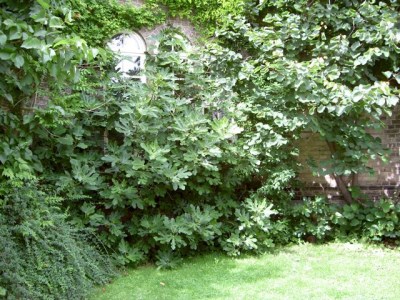
Photo1. Fig tree in the Botanic Garden of Lund In years when the winters are fairly mild it is possible to have a crop of figs in spring, and when the summers are warm it is also possible to have a crop in late summer. It is usually not necessary to protect the fig trees in winter. In some winters however there can be some die-backs on the branches. The most common variety sold in garden centres and nurseries in Sweden is 'Precose de Dalmatie' from Bornholm. It is often referred to as "the Bornholm fig" (Bornholm is an island outside the Swedish south coast, belonging to Denmark). However this connection is not obvious. A gardening consultant on Bornholm said that the origin of the Bornholm fig is very uncertain; it is not even clear if it is only one variety. He also says that some figs growing on Bornholm might have been introduced from Italy by artists living on Bornholm, or by Danish seamen sailing in the Mediterranean Sea. Also according to the above-mentioned Swedish botanist, working at the botanic garden of Lund, there are important uncertainties about the Bornholm fig. There probably exists several varieties of this fig. In the future I will travel to Bornholm and investigate this in more detail. I also hope to get opportunities to collect some fig cuttings and also to talk with people, which have fig trees, and ask them if they know anything about the history of their particular fig tree. It is possible, however, that 'Precose de Dalmatie' is a real variety, but I have not yet received any information about this. If it is a distinct variety, one might say that it is one of the varieties of the Bornholm fig. The Bornholm fig (with the name 'Precose de Dalmatie') is, as said, sold in Sweden in garden centers and nurseries. It is quite common nowadays. It is most often grown trained against a wall in the mildest parts of Sweden, that is, around the coasts in southern Sweden. It is also grown in greenhouses in other parts of Sweden. The beginning of my trials I ordered from USA two varieties of fig in the beginning of the 1990s. One of these ('Hardy Chicago') was said to be very hardy and the other ('Galbun') should grow and fruit well in a container. I kept both for several years in containers, and 'Galbun' fruited quite well, but 'Hardy Chicago' had almost no fruit at all. I also tried small plants of 'Hardy Chicago' outside and they survived my winters with heavy mulch. In 2004, I planted out my original plant of 'Hardy Chicago', together with another American variety, 'Desert King'. At the time, I started talking to Pierre Baud, who is the most important French nurseryman for fig trees, exporting all around the world, and who also is an eminent scientist in this matter (see his Internet site which includes an English version). Pierre Baud became interested in my experiments and suggested two hardy and very precocious varieties from his collection, named 'Ronde de Bordeaux' and 'Pastilière', which could be good candidates for a successful result. He proposed to send me these two varieties and extend the experiment with other varieties. I did not have enough space to plant more than the two above mentioned varieties, but a friend of mine, Håkan, living in approximately the same climate zone as I, and who is also a fruit tree enthusiast, kindly accepted to host them in a large piece of land he owns. We then received the figs from Pierre Baud; in total 19 plants. Very kindly Pierre Baud refused any payment, even for the shipping costs… I then prepared the soil for 'Ronde de Bordeaux' and 'Pastilière' and planted them out in the second half of May 2004. At the same time Håkan planted the other varieties and also duplicated my two varieties. July 2004 May, June and the beginning of July were unusually cold and rainy, with temperatures during most days below 20°C. During the last three weeks however, we had very hot weather, with temperatures ranged between 27-30°C. 'Ronde de Bordeaux' grew quite well, with a lot of shoots between 30cm and 50 cm. No signs of figs yet, however. 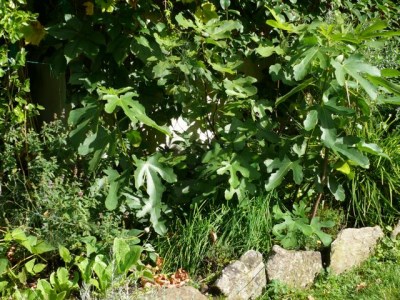
Photo 2. 'Ronde de Bordeaux' growing in the herb garden 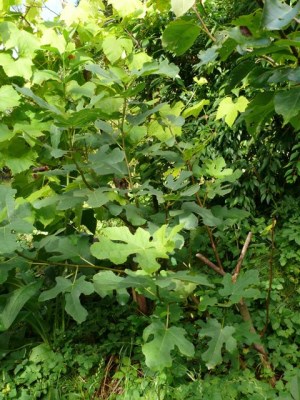
Photo 3. 'Hardy Chicago', planted in a south facing hillside protected from the North As I mentioned before I also planted out large plants of 'Hardy Chicago' and 'Desert King'. They grew quite well despite the rather cold summer. 'Hardy Chicago' developed in fact some figs. It will be interesting to see if they will ripen this fall. 
Photo 4. Small figs on 'Hardy Chicago' Unfortunately 'Pastilière' did not grow at all. I investigated the roots last week and found out that the plant was dead. I will try 'Pastilière' again. I received a mail from Pierre Baud and he promised to send me a new plant next spring. I will also ask him if he could send me a plant of the 'Bécane' fig which is 3 days earlier than 'Ronde de Bordeaux'. Håkan reports the following: Plants that had shoots of about 20 cm : 'Negronne', 'Sultane' and 'Bécane'. Plants that had shoots of about 10-20 cm : 'Brunswick', 'Tena', 'Goutte d'Or', 'Dalmatie', 'Brown Turkey' and 'Pastilière'. Plants that had shoots of about 10 cm : 'Ronde de Bordeaux', 'Sucrette', 'Figue de Marseille', 'Dauphine', 'Madeleine des Deux Saisons' and 'Longue d'Août'. Only 'Negronne' produced some small unripe figs. Håkan told me that 'Bécane' was the best grower all his fig plants this summer. July 2005 The summer was unusually late this year. During the last weeks however, we had a warm weather with temperatures between 25 and 30°C. The winter was very mild until late January (we had no frost at all most of January). By February the weather suddenly became much colder, with a minimum temperature at the beginning of March of -18°C. The spring was then quite cold, but we had no frost after April 25. My 'Ronde de Bordeaux' survived the winter well, without any mulching (just a thin natural layer of leaves). It was not injured by frost until spring time, when last year shoots died. I was in fact able to take a cutting of the last year growth in late February, which rooted easily. About two thirds of the main trunk survived, and have now produced 7 shoots, the longest being approximately 35 cm long. I planted out the two figs that Pierre Baud sent me this spring; both 'Pastilière' and 'Bécane' look healthy and grow well. My two 'Hardy Chicago' plants survived this winter. The large plant was mulched with 30 cm layer of leaves and was also wrapped with a tarpaulin. The main trunk survived up to 70 cm and the branches, which were covered with mulch also survived. The plant looked very healthy and had a lot of news shoots on the trunk and on the branches. The smaller 'Hardy Chicago' also had a mulch (but much thinner) of leaves and two stems were bent down and covered with some soil (2-3 cm). It survived, and grew very well. The 'Desert King' fig, also a large plant, survived the winter, but froze down to the ground. It was mulched in the same way as the large 'Hardy Chicago' and wrapped with a tarpaulin. This year I also planted a fig variety bearing the trademark 'Violetta'. It comes from Southern Germany, and is said to have withstood -20°C. It will be very interesting to see how it will succeed. It is also said to ripen its fruits very early. Håkan reports: Eight of his fifteen plants survived the winter (he is not sure if the rest actually died; he will investigate this later on). All of these died back to ground level. Four of the surviving plants developed quite well and each of them had four to five shoots of 5 to 10 cm long. These were: 'Sultane', 'Ronde de Bordeaux', 'Longue d’Août' and 'Dalmatie'. 'Tena', 'Goutte d’Or', 'Bécane' and 'Madeleine des Deux Saisons'. They started to grow but their development was weak. December 2005 Concluding remarks on the 2005 growing results: 'Ronde de Bordeaux' gew well during the summer. The seven shoots were between 30 and 70 cm long, but no signs of figs. 'Pastilière' also grew well (the longest shoot are up to 50 cm) and there were some small figs. S. 
Photo 5. ‘Pastilière’ 'Bécane' did not grow quite as much, but it looked healthy. I think that 'Ronde de Bordeaux' endured the winter better than 'Hardy Chicago' and 'Desert King'. A larger part of the trunk survived and the shoots were also more vigorous. Håkan told me that : 'Sultane', 'Ronde de Bordeaux', 'Tena' and 'Dalmatie' were the plants which developed best during summer. Each of them had four shoots of 30 cm or more. 'Goutte d’Or', 'Longue d’Août' and 'Madeleine des Deux Saisons' had one or two shoots, 10-20 cm long. 'Brunswick', 'Sucrette', 'Bécane' and 'Dauphine' were quite small. They had one or two shoots which were less than 10 cm long. The rest of the plants sadly did not recover from the injuries of previous winter. March 2006 We had an unusual long winter this year, and during the last week the weather was very cold (down to -19°C one night) with a lot of snow (the snow cover was between 40-50 cm). However, the fig looked quite healthy. But the real challenge for the figs would come later when the snow cover would disappear and the sun become warmer. December 2006 'Hardy Chicago' was seriously damaged by a deer in winter, and I thought it would have died, but it luckily recovered. 'Desert King' was somewhat damaged, but also recovered. Both had new vigorous shoots, the longest being about one meter long. As last year, 'Ronde de Bordeaux' grew well during the summer. It had nine shoots between 40 and 100 cm long. For the first year I could see small signs of fig growth, but they would surely die this winter because I will not cover them. 'Pastilière' grew quite well, but only produced two shoots (the longest was up to 40 cm) and no figs. 'Bécane' did not grow well at all, but still looks healthy. I will change it's location next year and see if it will grow better. 'Ronde de Bordeaux' seemed to be the most vigorous of the French varieties. I mentioned that I also tested a new German variety, whose commercial name is 'Violetta' and which is supposed to whistand -20°C. It survived the winter well but the main trunk froze down. Like 'Ronde de Bordeaux' a lot of new shoots developed during the summer, and there were already some small figs on them. These shoots will be bent down and covered with some soil and leaves during the next winter. Håkan reports : 'Sultane', 'Ronde de Bordeaux' and 'Dalmatie' were, similarly to last year, the plants that developed best. They grew shoots of 50-60 cm. 'Ronde de Bordeaux' also had some figs on the shoots, about the size of cherries. Unfortunately some frosty nights, a month ago, killed them. 'Goutte d’Or', 'Longue d’Août', 'Madeleine des Deux Saisons', 'Sucrette', 'Bécane' and 'Dauphine' had shoots between 20-30 cm long. 'Brunswick' struggled and was still very small, around 10 cm. September 2007 Last winter was relatively mild in southern Sweden, the minimum temperature was only of -12°C at my place and we had cold weather only during short periods. The foregoing autumn was also warm and long. This meant that there was not that extensive dieback on the fig bushes during winter as it was the case in the preceeding years. The summer however was quite cold, especially July, with very little sun. As in previous years 'Ronde the Bordeaux' looked very fine, and grew fast. This year it had 6 solid shoots, which were up to 120 cm long. No signs of figs yet however. 'Pastilière' seemed so far to be the hardiest fig that I am testing. It did not grow as vigorously as the other figs, and seemed also to harden its wood much earlier. No figs yet. Last year, the 'Bécane' plant was in a very bad shape, but somehow recovered. It started to grow again, but only about 15 cm. The two 'Hardy Chicago' plants survived winter extremely well, with almost no dieback at all. The biggest plant had some small figs on it, but they were too small to ripen during autumn. One plant was more than 1 1/2 meters high and the other around one meter. Both had a lot of shoots. 'Desert King' looked miserable early in the summer, but recovered and put out several long shoots (up to one meter). No figs at all. 'Violetta' had, differing from the other figs, several diebacks, but it is was also the youngest plant. However, it grew vigorously during the summer and had until now 7 shoots up to 120 cm. No figs yet 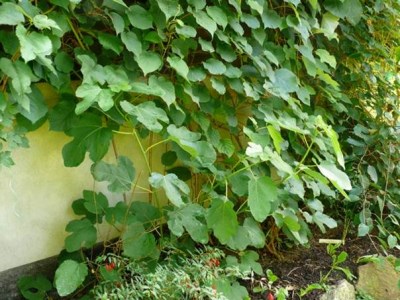
Photo 6. ‘Violetta’ fig. This year I also planted out a fig I received from Sergio Carlini, an Italian fellow member. He calls it 'Gallo' and says it is early ripening and might also be quite cold resistant. It was originally obtained from an old man living in the Italian mountains. 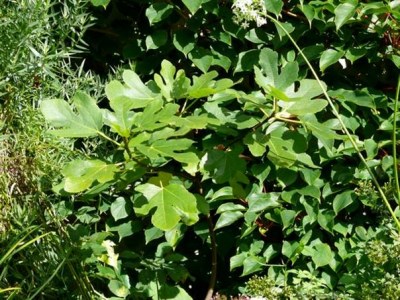
Photo 7. Small plant of ‘Gallo’. Håkan reports : Five plants died during the winter. It is possible that mice killed them. All the remaining plants grew quite well this summer with a lot of shoots (between 6-8 in each plant). No figs at all this summer. The best plant this year were 'Sultane', which grew to about 1 meter. The second best were 'Longue d’Août' and 'Dalmatie', about 60 cm. 'Ronde de Bordeaux', 'Goutte d’Or' and 'Sucrette' were 50 cm high. September 2008 I did not receive any report from Håkan for 2008 because he moved his plants to a new location. I can tell you that I found last summer quite a big fig bush in central Gothenburg, not far from where I live.. It was really a surprise as I had never seen a fig in Gothenburg before (photo 8). Unfortunately it was cut down in October because they made some renovations on the house. It was about 3 meters high and 4 meters wide. 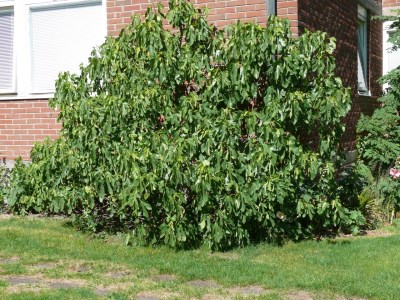
Photo 8. Fig bush in central Gothenburg We had a very mild winter this year, with temperatures dropping to about -11°C one or two nights. A large part of the winter was actually frost-free. The summer came early with very hot weather starting in May. Unfortunately the weather was also dry the first part of summer, with almost no rain at all during a period of 1 1/2 month. All fig plants looked very healthy, and some of them had no damages at all in winter. 'Ronde de Bordeaux' had some winter damage, and last year shoots were killed to about 75 cm above ground. There were some signs of very small figs on the plant. 'Pastilière' died back to about 10 cm above ground, but recovered with three shoots, with the largest being about 40 cm high. No signs of figs. I moved the 'Bécane' plant last year, and put it in a pot that I kept inside, during winter, in a cool place. It recovered and I will plant it next year in a better position in the garden. My two 'Hardy Chicago' plants survived the winter with almost no damage at all. They also developed well during summer, but growth was a little less than previous years, which I think was caused by the lack of rain. For the first time they produced small figs (photo 9). Two of them ripened but were unfortunately eaten by birds while I was away for some days. 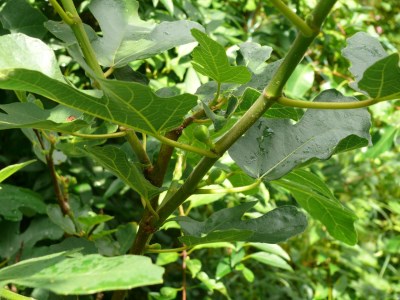
Photo 9. Small figs on Hardy Chicago The 'Gallo' plant that I received from Sergio Carlini survived winter extremely well with no damage at all. It also started producing some small figs in July, which however didn't ripen during autumn (photo 9). I think that this variety might be quite exceptional because it is still very young and small and yet so cold hardy and bearing fruit so early. 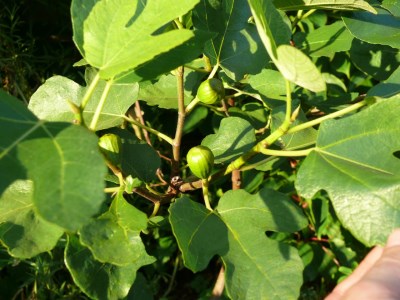
Photo 10. Small figs on Gallo plant 'Violetta' died back to about 40 cm above ground, but recovered with a lot of shoots. No figs at all. 'Desert King' looked even worse this year, so I am thinking of removing it from my trials. 2009-2010 Here is my fig report for the winter, spring and early summer 2009 – 2010. We had an unusually cold and long winter; almost two months with negative temperatures on several occasions below –15C. One night the temperature went down to –19C. During these months, the snow cover was also very thick, up to 75 cm. When I looked at parts of my fig plants that were above the snow they looked really healthy and I thought that the snow cover protected the plants effectively. And it probably did. However, under the snow mice had been eating on the stems down to the ground on all my figs and completely destroyed the plants. So unfortunately I don’t have much to tell about my trials. What I am looking for now is new shoots from the plants and I discovered them on 'Hardy Chicago', 'Gallo' and the very hardy clone I got from a French friend. 'Violetta' was completely dead and I also thought that 'Pastiliére' was dead. 'Ronde de Bordeaux' seemed to be alive, but I did not see any new shoots yet. This was of course very disappointing, but it was obvious that the damages from the mice caused this small catastrophe. I am not pessimistic about the future, even if it delays my trials. Now that I know that mice can be a problem, it is easy to protect the plants. This year I will plant out two new varieties: One from Sergio Carlini in Italy called 'Vallecalda' and and a French variety, 'Madeleine des Deux Saisons'. 2011 The winter 2010 to 2011 was also unusually harsh, even if temperatures didn’t reach last winter’s very low temperatures.. On the other hand the winter was longer, with negative temperatures during most of the winter months. This unfortunately had disastrous effects on my fig plants as they all died down to the ground. ‘Hardy Chicago’ recovered and set out new shoots about 60 cm long, and ‘Ronde de Bordeaux’ was almost as vigorous. None of these shoots produced any figs however. Sadly I could conclude that the ‘Gallo’ fig was dead after the winter. The damages from the mice during the previous winter weakened it too much. As I described earlier in this article this fig seemed otherwise to have a very good cold hardiness. ‘Madeleine des Deux Saisons’ which I planted out last year was very weak, and had shoots less than five cm long. ‘Pastilière’ was completely dead. 'Figue de Langres' froze down but had new shoots of about 30 cm. This year I received a new variety from a French collector, called ’St. Martin’, which was said to be very hardy. I will keep it for the first year in greenhouse and plant it out in 2012. I also have a new Swedish variety from a manor in Southern Sweden. The friend who gave it to me said that it had been growing there for a very long time. I already planted it out. I am sorry to inform that Håkan is not able any more to participate to the fig trials. He has moved to a new house and working with a new garden and feels that he has not time for this project anymore. 2012 Also winter 2011-2012 was a cold one and it caused the same winter damages on figs as the last two years. We had some frost at the beginning of May (–4C), which was very unusual, that also damaged the figs while they had just started budding out. I am in fact thinking of starting to bend down the trunks to the ground and mulch them before winter to see if this improve their hardiness. This year I got cuttings of three very interesting plants from a person in Bulgaria, Pencho Genow. They are called ‘BG Gold’, ‘Vagabond’ and a third variety with a bulgarian name. They seem to have withstood very cold winter weather in Bulgaria. From Italy I got some new plants from Sergio Carlini, who was so kind to me earlier on. He sent the varieties ‘Tramonti’, ‘San Geomo’ and a third variety he couldn’t remember the name of. All these new plants were kept in my greenhouse during the summer and the autumn. ‘Hardy Chicago’ was still the variety that developed best during summer followed by ‘Ronde de Bordeaux’. ‘Madeleine des Deux Saisons’ died but the new unnamed Swedish variety survived winter quite well, and developed slowly during summer. I let the variety ’St. Martin’ an additional season inside the greenhouse and it is growing quite slowly. 'Figue de Langres' froze down to about 15 centimeter but recovered during summer. I am thinking to move it to a better place with more fertile soil. Sadly the variety ‘Vallecalde’ died during winter. I had some hope for this but I have another plant that I will place in a better position next year. |
| © Bo Blomqvist - 2004-2013 (click here to contact the author) |